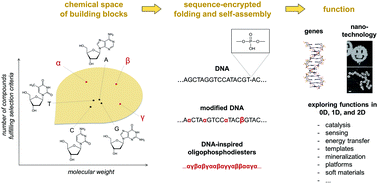DNA-inspired oligomers: from oligophosphates to functional materials
Abstract
To exert its role of a functional polymer, DNA relies on a molecular self-assembly process that is driven by the interactions of only four units placed in a defined order. Extending the structural diversity of recognition motifs in DNA, to and beyond analogues of the nucleobases, will open doors to self-assembled materials with advanced programmable properties. DNA-inspired systems are becoming useful for numerous applications unachievable by the nucleic acids in their native composition. Potential applications of rationally designed oligo- and polyphosphodiesters reside in the areas of drug delivery, diagnostic signalling and imaging, in systems for efficient energy transfer or the precise ordering on the nanoscale. The field of DNA-inspired phosphodiesters highlights the general value and utility of precision in the composition of oligomers and polymers. In this tutorial review, we will summarize the approaches of directing the self-assembly of DNA-inspired, sequence-specific polyphosphodiesters into soft materials with unique properties. These data expose the so far underexploited potential of DNA-derived systems in solving some of the key issues in various technological areas, such as advanced biomaterials, morphologically defined soft matter or the controlled polymer folding and assembly. Moreover, precise positioning of structurally diverse molecules within a polymer chain creates unmatched opportunities for encoding information on the molecular level and transmitting it further to the microscopic and even macroscopic level via noncovalent interactions.



 Please wait while we load your content...
Please wait while we load your content...